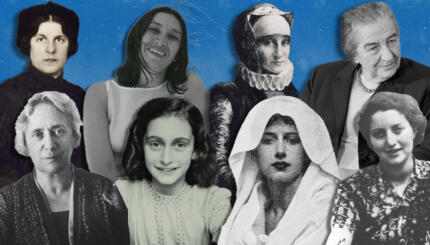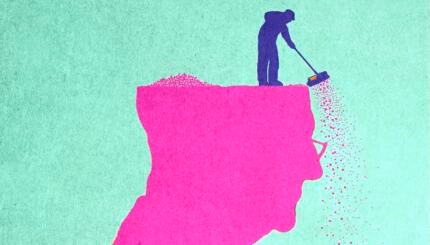Jews read sections of the
each week, and these sections, known as parshiyot, inspire endless examination year after year. Each week we will bring you regular essays examining these portions from a queer perspective, drawn from the book Torah Queeries: Weekly Commentaries on the Hebrew Bible and the Torah Queeries online collection. This week, Joshua Lesser looks to the holiday of Rosh Hashanah to find a more expansive vision of Judaism.
“Folks, in a moment we are going to hit the birth canal,” the leader of our spelunking trip chuckled. I felt the air thin as the 20 of us, mostly strangers, gasped at his description. Up ahead in the cave was a narrow tunnel that would require us to get on our bellies and contort and wriggle our bodies to make it through to the other side. Already muddy, I did not relish this part of the trek. I imagined spiders lurking in the dark. Taking deep breaths, I proceeded in line on hands and knees. Our headlamps provided little help as we moved forward, feeling the sides narrow. I imagined being trapped and buried under the earth. I heard the grunts and whimpers of those around me, straining to make it through, as we all lost any remaining sense of grace or composure.
My brief time in that cave is exactly how I feel about Leviticus, particularly when the texts of Leviticus are used to constrict Judaism and to squeeze people out of faith communities. I am frequently asked to speak about Judaism and homosexuality and how to reconcile Leviticus, its prohibitions, and its declarations of abominations. Recently I came to an important realization: using Leviticus as the starting point or the end game to talk about Judaism and homosexuality is a trap. By doing so, we buy in to a fundamentalist view that there is a narrow path to God and only a limited few can get there. Using Leviticus this way is to agree that Judaism is a religion of narrow laws that do not always have meaning, and that we have to contort and squeeze ourselves to make it through, often leaving our sense of dignity behind. I reject this Judaism because it is faith described as a weapon. I reject this kind of Judaism because it says blind allegiance to law is more important than people, and thus, misses the entire point of being Jewish.
Those who see Jewish law as an end in and of itself, and not as a means to a wider purpose, would subject us to a labyrinth of narrow places, with only the tool of a dimly lit headlight to look for cracks and fissures in order to breathe. Searching for breathing room in the legal loopholes is a stimulating intellectual exercise, but too often it can remove meaning and even God’s presence from the text. But the greater trap for us is to get completely caught up in railing against and rebelliously rejecting this Jewish way of living. Doing this we allow our “religion” to be reduced to what we don’t believe in, what angers us and what seems unfair. This may keep us out of the labyrinth, but it is not nurturing and does not support spiritual growth. It is a negation of faith, not an affirmation of God’s presence in our lives.
I don’t want to live in the confining labyrinth of Leviticus anymore. I do not want to struggle against others’ definitions of what being Jewish should or should not be. Instead, there is another ancient paradigm of the purpose of Judaism that sees law and ritual as tools to a meaningful Jewish life that honors God and humanity. I want to live a Judaism that is responsive to who I am and deeply rooted in tradition. I find us being directed to this Judaism when taking a deep look the occasional co-incidence of Rosh Hashanah and Shabbat. This is a Judaism that sees experiencing God as the force of Creation and Love.
Both Rosh Hashanah and Shabbat share a common text: Shir HaShirim – the Song of Songs. The Song of Songs was chosen by the mystics of Sefat to welcome and entice the Shabbat presence. Shir HaShirim is relevant to Rosh Hashanah, the world’s birthday, because, as the Sages suggest in Shir HaShirim Rabbah, the setting for this sensual love poem is actually the Garden of Eden. The Song of Songs is thus a description of creation at its very origin. The feminist scholar and poet Marcia Falk describes this ancient text as a unique lyric celebration of eros emphasizing mutuality in relationships. The lovers in the Song of Songs equally declare affection, invite each other to love making and share in an exchange that is never based on domination or subordination.
From the Song of Songs:
My beloved called out to me and he said, “Rise up, my dear mate, my beautiful one and come to me. Behold, the chill has fled and the rain has ceased and gone on its way. The blossoms have appeared throughout the land. The time for pruning has arrived and the voice of the turtledoves can be heard around our land. The figs have livened up their hue and the vines are bursting with their bouquet. Arise, my dear mate, my beautiful one, come to me. My dove who is nestled is hidden in the crevice of the rock, in the hollow of the steps’ ascent, reveal your form unto me and let me hear your voice, for oh, how sweet is your voice! My love is mine and I am his, who grazes me amongst the roses.” (Ch. 2, 10-17)
Although the text is highly erotic and sensuous, the rabbis chose to understand it as a love poem between God and the people Israel, rather than between two people. Either way this text contains a powerful message of passionate, playful and engaged loving and love making.
Rabbi Akiva of the Talmud, said. “All of Scripture and its texts are holy, but the Song of Songs is the Holy of Holies.” Akiva is saying that the Song of Songs is the central and primary text of Jewish living. In doing so, he points to another way of understanding Judaism, in contrast to Leviticus and its narrow labyrinth of prohibitions. In this vision of Judaism, the purpose of everything we do is to be engaged in a highly evolved love and sensual awareness of God’s presence in the Universe.
Am I suggesting that the epicenter of Judaism is “free love”? Not quite. Let’s break down Rabbi Akiva’s metaphor. If the Song of Songs is the Holy of Holies then all of the other texts exist to serve the Song of Songs. The Song of Songs is a poem about experiencing God’s presence and essence through a passionate, ego-less, and boundless loving. But this is more than advocating the most intimate connection of our lives; it is an erotic message of union in which identity disappears and all that remains is attention to God and creation.
But as we reflect on this metaphoric Holy of Holies, we must remember that the physical Holy of Holies, the Temple’s inner sanctum, was not an easy place to enter and was full of danger. Only the High Priest entered the Holy of Holies and only on Yom Kippur. Even then, if he did not follow the ritual with the utmost care, he would die. We must understand then that the passionate selfless loving at the center of Rabbi Akiva’s Judaism is not easily achieved.
Perhaps this is why so many of us get lost. We have our sights on the Holy of Holies but we forget that there are many steps leading up the Temple and many doorways to pass through. So as we seek to understand love as central to Judaism, we must remember that love manifests in many different ways and that the path to love is never simple. I suggest we back up, head all the way down the Temple steps, leaving Jerusalem even (metaphorically speaking), and see the Song of Songs as the ultimate but nearly unachievable goal. By having this as the spiritual goal, the Song of Songs would have us as Jews evaluate all that we do by asking “does it increase a sense of loving presence in the world?” The way we celebrate our holy days, the social justice we enact, the grieving of lost relatives and the cultivation of memory, baking challah and putting up mezuzahs, praying and meditating, being mindful of what we eat and how. Do these things, and the way we do them, guide us on the path of Love?
Take a moment and reflect: What would Shabbat look like if the purpose of it was to enhance love? Ceasing from work, focusing on family and friends, and navigating the day without the distractions of work or money liberates us to be present to the people around us. What would Shabbat look like if we spent time mindfully and selflessly offering prayer and seeking a closer connection to God and community? In this paradigm, intimacy is the goal, not the by-product.
Where do we begin? How do we enter these high holy days of Rosh Hashanah and Yom Kippur and come to life with a new purpose, a new beginning? How can we use these days to increase our experience of love? In preparing for the High Holy Days I was struck by a question that has continued to emerge for me, and which I have adopted as my own this season. That question is: “What keeps us separate from people? How do I separate myself from you?”
It is separation that prevents us from experiencing love and feeling connection. The act of seeking teshuvah, a sense of return, fosters our taking responsibility for the clutter and messes we have caused in our relationships with others, our relationship with ourselves and our relationship with God. On these High Holy days we are encouraged to seek and offer forgiveness. This requires us to repair our relationships to bring us closer to those around us, to ourselves and to God. Viewed this way, experiencing love becomes the central experience of God’s presence during these Days of Awe. Likewise, experiencing and affirming love becomes the central experience of Judaism, in contrast to the narrow confines of Leviticus or the constraints imposed by observing the law for its own sake.
Back in the birth canal, deep in the cave, surrounded by a thick darkness, a woman I had never met before began to freak out. “I can’t do this,” she cried. “I want to go back.” She had stopped moving. You could hear the panic in her voice. A man behind me gruffly told her to keep moving. I felt a sympathetic constricting panic rise in me. “Breathe, Josh, breathe,” I said to keep calm. Other voices began to urge her along with sharp edges. She began to cry. I spoke to her: “Ssssh. Hi. I am Josh and I am right here with you. Just breathe.” I kept speaking, encouraging her to listen to my voice. “You will be just fine. Put one knee in front of the other. You’re doing great.” Every now and then she would cry, “I can’t!” and in my gentlest voice, I would remind her to breathe, that she was okay and that she would make it. Arriving into the open cavern, she told me “Thank you, I love you.”
Judaism does not have to be the narrow crevasse where we feel trapped; it can be the opposite. Judaism should and can be the place where we are able to become unstuck and reach out to others and help them through the narrow places into the expanse. It is through the process of reaching out and of accepting help, the process of connecting with others and connecting with ourselves, that we have access to God. The woman in the cave did love me in her accepting of my help, just as I loved her by connecting to her by offering my help. It is this process that has us emerge from the dark to feel the light of Divine love – and this is a Jewish way of living in which we can all find a home.
Rosh Hashanah
Pronounced: roshe hah-SHAH-nah, also roshe ha-shah-NAH, Origin: Hebrew, the Jewish new year.
Shabbat
Pronounced: shuh-BAHT or shah-BAHT, Origin: Hebrew, the Sabbath, from sundown Friday to sundown Saturday.
Yom Kippur
Pronounced: yohm KIPP-er, also yohm kee-PORE, Origin: Hebrew, The Day of Atonement, the holiest day on the Jewish calendar and, with Rosh Hashanah, one of the High Holidays.


